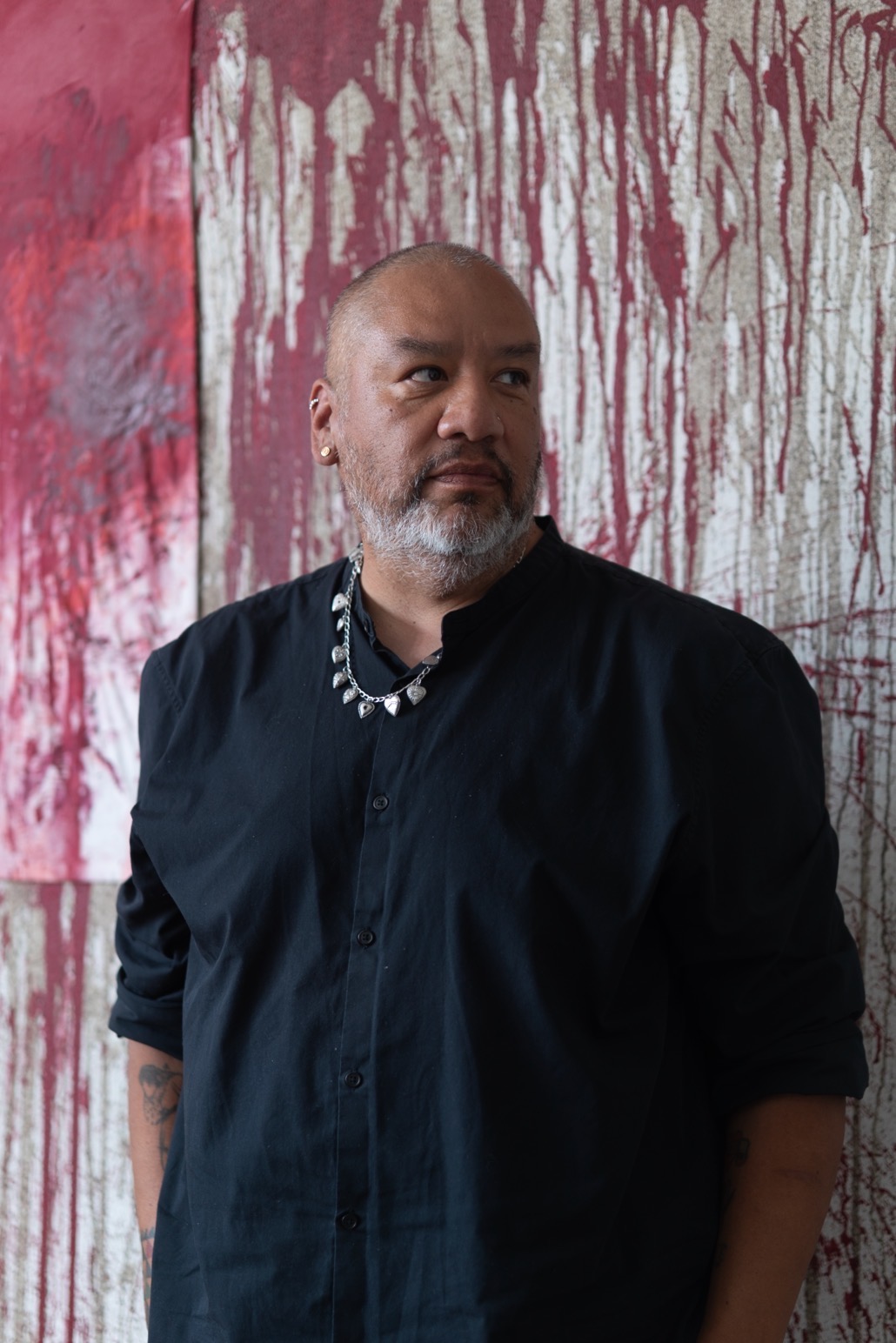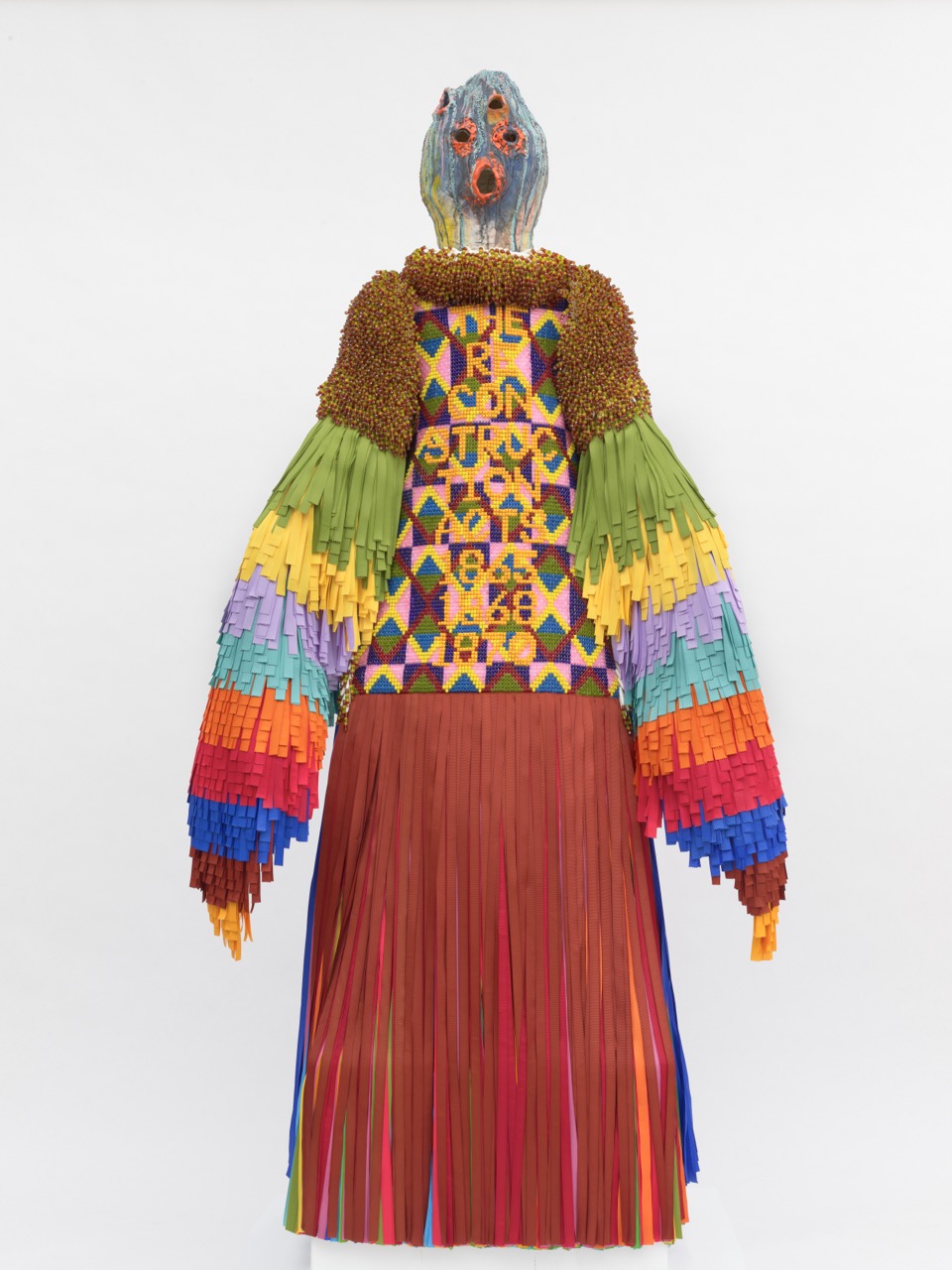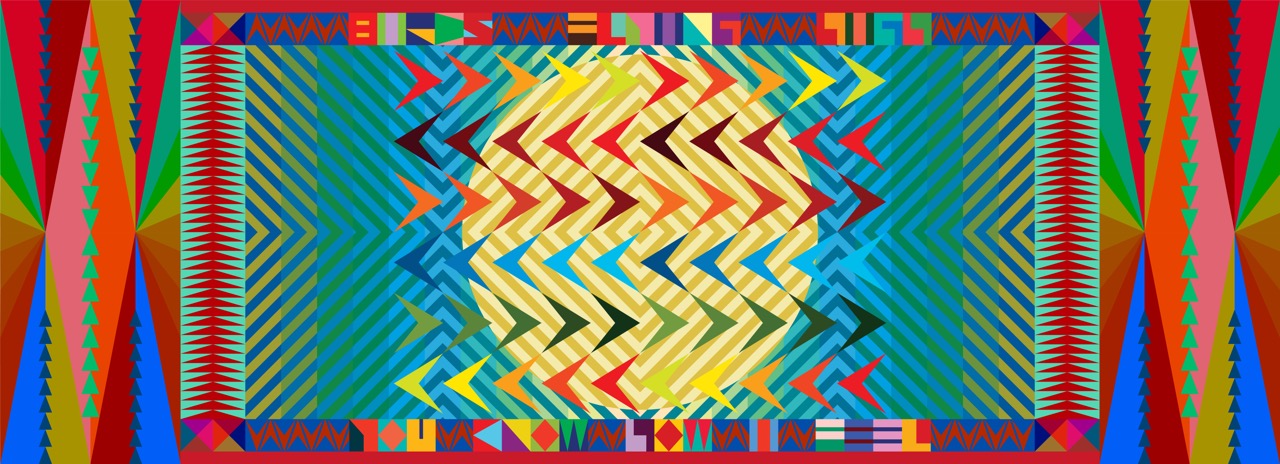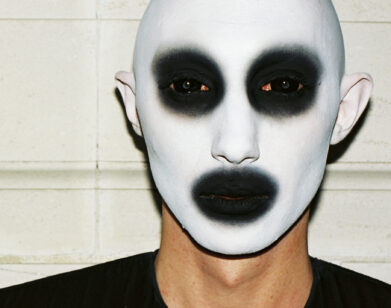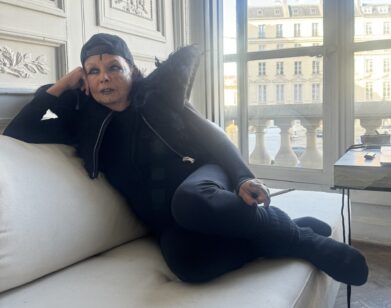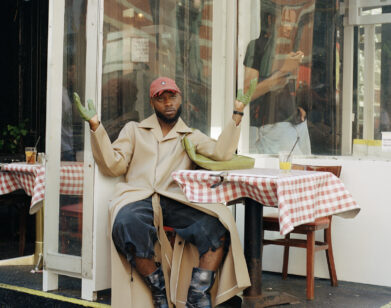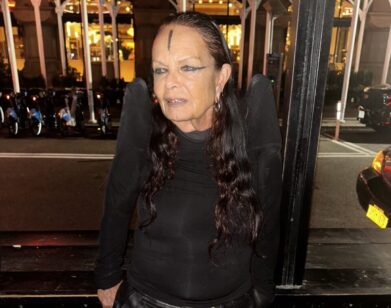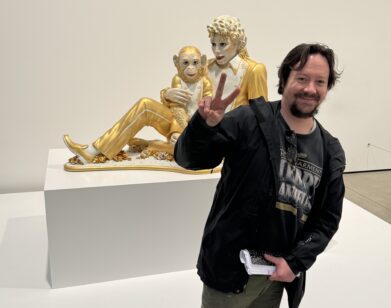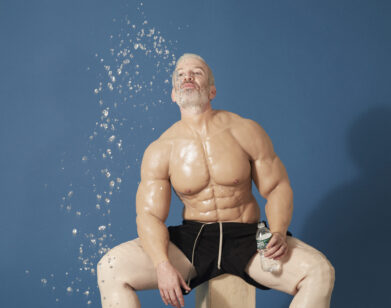IN CONVERSATION
Jeffrey Gibson Tells Michèle Lamy How Rave Culture and Porn Collectors Inspire Him
In Jeffrey Gibson’s world, punching bags are beaded, mannequins don jingle dresses, and slogans shimmer in sequins. Working across painting, sculpture, and video installation, the Choctaw-Cherokee artist enlists a variety of forms, colors, and textures to comment on the many injustices baked into American history. In 2024, he became the first Indigenous artist to present a solo exhibition at the Venice Biennale’s U.S. Pavilion. Now, that landmark installation has made its way to L.A. in Jeffrey Gibson: the space in which to place me, his first solo museum show in Southern California, now on view at The Broad until September 28th. To mark the occasion, he phoned Michèle Lamy, fashion’s high priestess of the avant-garde, for a wide-ranging exchange about ancestry, the color black, and the grim state of the world. “The news is all fucked,” lamented Lamy. “We need a shaman to show us the way.” Gibson might be the right guy.—OLAMIDE OYENUSI
———
MICHÈLE LAMY: All right. You are in the forest?
JEFFREY GIBSON: I’m in the forest at the beach in Long Island.
LAMY: Wow, I’m at the beach also.
GIBSON: Where are you?
LAMY: I’m in Venice at the Lido.
GIBSON: Last year, we went to the beaches in the Lido every day that we could.
LAMY: That’s what we do when we are here. Even though my immersing in your world was in Venice, you had already said no to me at a point. I was doing something with Selfridges and I wanted to have an artist’s boxing bag, but it seemed too complicated at the time and I was like, “No, we have to push for you.”
GIBSON: I wish I could have said yes to you, but it was not possible at the time.
LAMY: So how come we got to be talking together? Where did this come from?
GIBSON: You were my first choice. I’ve been a huge fan for a very, very long time. I think you’re an incredible creative mind, and I know you spent time in L.A.
LAMY: L.A. has been so important, and it still is. I lived there 30 years. Are you there?
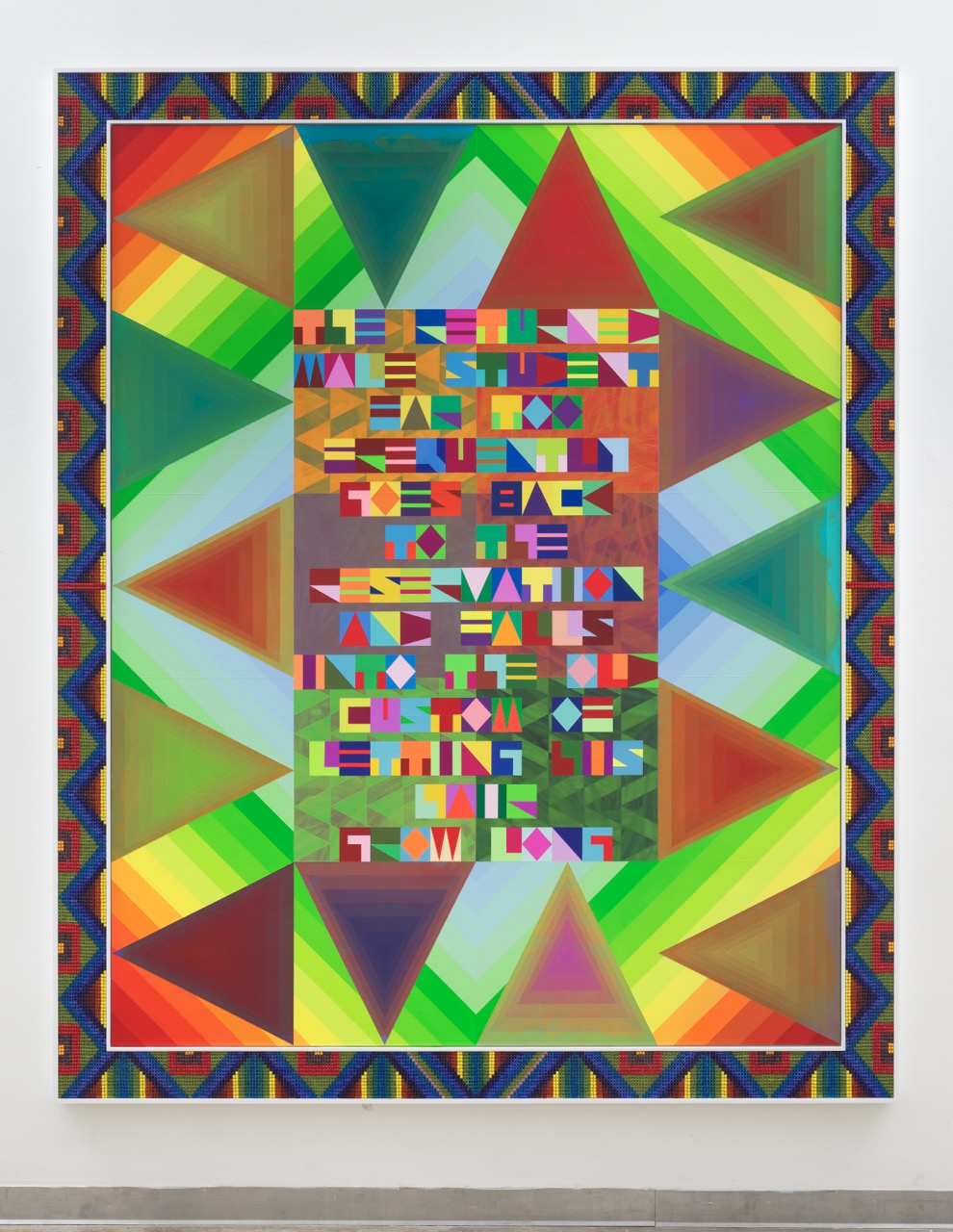
THE RETURNED MALE STUDENT FAR TOO FREQUENTLY GOES BACK TO THE RESERVATION AND FALLS INTO THE OLD CUSTOM OF LETTING HIS HAIR GROW LONG, 2024. Courtesy of Jeffrey Gibson Studio. Photo: Max Yawney.
GIBSON: I don’t live there. But I’ve been invited to exhibit there.
LAMY: Which gallery are you with?
GIBSON: Hauser & Wirth.
LAMY: So you like to do shows all over the world?
GIBSON: Well, it’s kind of a new thing. I’ve mainly shown in the US for about 20 years, but I grew up in Germany and in Korea. I went to school in London.
LAMY: But how come you are married to somebody from Northern Europe?
GIBSON: From Norway? We met in London. I think growing up the way that I did, I really truly believed by this point that love would be happening across all the borders. I just imagined a very different time than the world we live in now. When I met my husband, Rune, within the first eight hours we told each other we loved each other.
LAMY: Yeah?
GIBSON: Yeah. He’s an artist also, so I think that’s what brings us together.
LAMY: And now art is a way that we can open our mouths about the horrible time we are living with. Because of this genocide, there have been a lot of people wanting to analyze what happened in the US with people invading the land. What is fantastic is you are an artist from now, but there is this past that has been sort of shoveled away for a long time. Is that something you always had in you?
GIBSON: I believe very much in ancestral memory and ancestral trauma. We inherit our circumstances, and part of acknowledging the past of my family and of all indigenous people here in North America is about trying to find sanity so that you don’t crumble. I feel very, very fortunate to be an artist because art has given me an opportunity to lean into things that don’t seem practical. They don’t have to be linear, they don’t have to make sense. It wasn’t really until 17 or 18 that I started seeing people like Warhol and Keith Haring and Grace Jones and thought, “I need to be in New York City.” That became my pursuit. I had a friend from Ghana and she challenged me to go to London. She was like, “You need to get out of here and develop yourself as an artist in a place where people aren’t asking you, “What are you? What are you? What are you?” I enjoy being a foreigner because you get to shed one part of yourself temporarily and then pick it back up.
LAMY: That’s why I moved to L.A. So in London, you were even more free to place yourself there than in the past.
GIBSON: Yeah, and I actually got to look at art. I think in the US at the time, everything was sort of identity politics-driven, which at one point really benefited me, but I didn’t feel like I was learning so much.
LAMY: Something that I like about London is that it’s really a melting pot of a lot of people and music and everything.
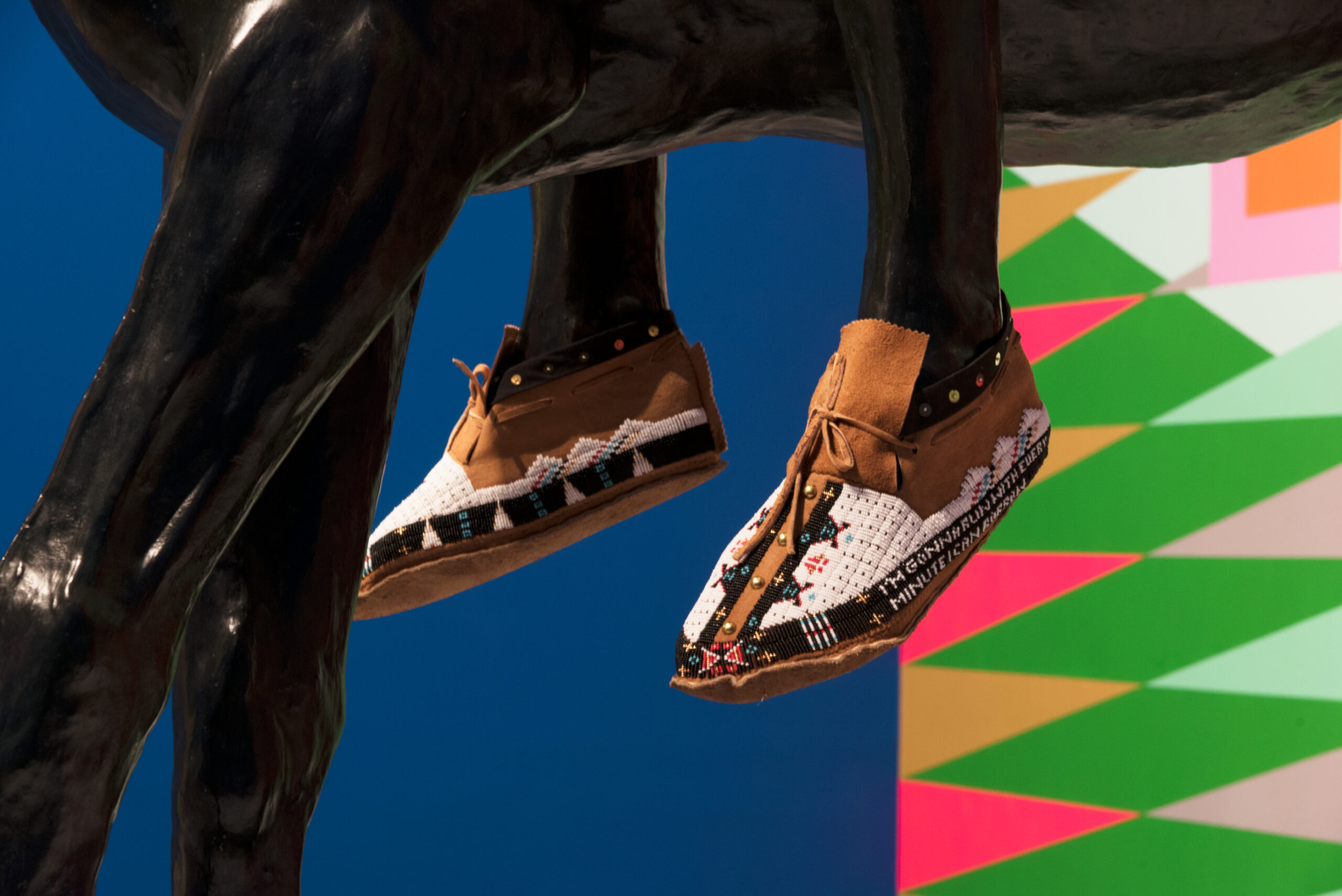
Installation view, Jeffrey Gibson: When Fire Is Applied to a Stone It Cracks, Brooklyn Museum, February 14, 2020-January 10, 2021. Photo: Jonathan Dorado.
GIBSON: Everybody in London at the time saw me as a Black person. There was no Native American community in London, so my time there was pretty incredible. Goldie had his club, Metalheadz, and there was still a carry-on of rave culture. It was a really big relief to be in London.
LAMY: You talk about clubs. So, drum and bass?
GIBSON: A big influence for me was Leigh Bowery. He had died just before I got there. Before that, I was in Chicago from ‘92 to ‘96. Chicago house music was my world. Derrick Carter used to play, and then Derrick Carter went to London. London is a very cool place and the people who I met there were really influential. I met Hélène Cixous, who brought me to Paris and introduced me to her theater and her friends. We did a project together.
LAMY: Leigh Bowery put you in the mood to do performance? There is a big retrospective right now at The Barbican. I knew about Leigh Bowery, but I was already in the States. I saw him in New York.
GIBSON: Oh, yeah?
LAMY: For Wigstock. I came back with Michael Clark, who was such an inventor in dance and performance.
GIBSON: The thing about Leigh Bowery was, first of all, he was about my size. He was a big guy. In gay culture at the time, which was all about muscle and tiny little boys, to see somebody like Leigh Bowery running around the streets with no clothes on and performing his work with Michael Clark, that’s what made me start making garments for myself. If you think about it, it was after the height of the AIDS crisis. When I was in my 30s, I began to understand the kind of politics that were happening more. The urgency, the death, the trauma.
LAMY: The AIDS crisis was before you went to London. It happened in London, too.
GIBSON: Yeah. I wasn’t really aware of it because I was 18 in 1990. Now I’ve met a lot of those people who lost everybody in their lives during that time, and I can’t imagine. I grew up in the generation just after it, which is a different kind of sexuality and gender. I did a video this past year where I wore my own garments, and it’s based off of the Leigh Bowery performance at Anthony d’Offay in ’88. I wish I had met him. I think the way that Leigh played with camp was smart. It was very pointed. It had an opinion. It’s aware camp. When I was in my schooling, there weren’t so many people who understood that camp can be a tool of critique.
LAMY: Then when you are in a place like the Biennale, it is more from the past and you make it completely present.
GIBSON: Venice has a very specific context. I started going to the Biennale in 2005, and I went with a Native American curator named Kathleen Ash-Milby. She was the co-curator for my exhibition. We would be in vaporetto like, “What if, one day…?” I saw her go through many attempts, and when I decided to propose and I was selected, there’s a lot of responsibility that I knew was expected of Native communities in particular. I think it would’ve been a mistake for me to go solely as Jeffrey Gibson. I’m not a traditionalist, so if I want to work with something traditional, my first thought is always, “Who is the traditional person?” Ultimately, it is a kind of collaboration, but it’s not like I alter what they do and they alter what I do.
LAMY: Yeah. And that huge red splash! What’s going on in that?
GIBSON: I’ve been looking at a lot of Black American artists in the ’60s and the ’70s who really remain true to their practice of experimentation, abstraction, and individualism. Artists like Sam Gilliam, Ed Clark, and even some of David Hammons’ conceptual works. They keep the space open for multiple answers. They’re never trying to shut it down into resolution, and that’s the lesson I take away from them. I think the way that we define each other in the world, by race or by nationality, is not anything I’ve ever truly believed in. I grew up moving across all sorts of borders and it made my life better. That’s the world that I believe in.
LAMY: So now your next show is in Paris?
GIBSON: Yes, and it’s incredible talking to the gallery in Paris because in the US, oftentimes I’m confined to conversations around known Native American histories. I’ll make something and they’ll be like, “Where does this come from in your culture?” For me to say, “Oh, it also comes from Korea, and it also comes from drum and bass, and it also comes from rave”—it’s too much for the conversations here to absorb. This is why French philosophers have been such a big influence on me. If I mentioned that in the US they’re like, “What does French philosophy have to do with being Native American?” In France, they were like, “Fantastic. Anyone coming off the street will be familiar with what you’re talking about.”
LAMY: Are you Deleuzian?
GIBSON: I am very Deleuzian. Deleuze makes perfect sense to me.
LAMY: That’s why you want to talk to me, because I met him the first years I was at university. He was teaching in Lyon on what became The Logic of Sense. Then Michel Foucault says the 21st century is going to be Deleuzian. You are the only one to talk about this in the States.
GIBSON: It’s funny because the way that those thinkers articulated what they saw in the world really predicted the times that we’re living in. We’re experiencing all of the inevitable conflicts of living that way. Unfortunately, I’m not sure that it’s going to get better anytime soon.
LAMY: No, because we are at the end of a certain civilization, of those white hetero males and their last fight of power. I don’t know how to prepare more than just having a voice and trying to do something, but I’m pulling my hair. What can we do? I don’t know how it’s going to end. I’m old, so I would like the thing to go faster.
GIBSON: When COVID lockdown happened in the US, I reached out to two people, AA Bronson and Avram Finkelstein, who was one of the founders of Gran Fury.
LAMY: Yeah, I know him.
GIBSON: I spoke to them because I was teaching and my students didn’t want to make artwork anymore. They were like, “What’s the point?” So I was asking them about how they continued to make artwork as the AIDS crisis came into their lives, and what I learned was that it doesn’t always change you. If you’re already engaged in communities and then something’s happening, you continue engaging in those communities. Right now it is tough thinking about being an artist because much of what I want to make is for the future.
LAMY: It is, but the news is all fucked up, and we need a shaman to show us the way. Do you think that boxing helps you to believe in what you do and be strong?
GIBSON: Well, my introduction to boxing came through my therapist. I was talking about homophobia and racism and classism in the art world, and there was anxiety in my head, but I wasn’t able to do anything with my body. He introduced me to a physical trainer. She would hold the bag and say, “Who do you want to hit? Who do you want to kick?” I was trying to imagine a person, and then I realized those things are faceless circumstances. I think I was afraid to be angry at a time in my life, but you don’t want to hold onto anger. If it’s not my problem, I don’t want to carry it.
LAMY: [I did it] 50 years ago at the Wild Card Boxing Club. It was also to change ambience and be with those guys instead of being at the gym pushing iron. And it was the beginning of women really starting to fight. The bag always shows something—it’s an image, but with you it was a fantastic image.
GIBSON: The first punching bag that I made, I was meeting with very traditional Native artists out in the reservations in Oregon, Winnipeg, and South Dakota, people who were making their own music, jewelry, and clothing. There was something about the way that they were showing their independence. It commanded respect. One day I was boxing and all of a sudden it just came together. I was like, “Oh my gosh, if the bag is dressed, I don’t want to hit it.” That was the beginning of the punching bags. And then the text came in when thinking about incantations that have to do with power and relationships. There’s something about visual self-respect that diffuses anger for me, especially with Native people when it comes to regalia.
LAMY: You quit your shrink after you continued to do boxing?
GIBSON: Five years later, I tried to include my shrink in a performance. It was at the Museum of Fine Arts in Boston. I called him up and I was so excited like, “We’re going to do a session in front of an audience,” and it was going to be about my grandfather and Jackson Pollock. He refused. He said it was unethical.
LAMY: Wow. What about AI?
GIBSON: Oh my gosh. Well, it’s such a weapon because it is believable. We’ve already come through this intense media onslaught of the 20th century, and our bodies can’t handle what we’re already receiving. And then on top of that, reality, fiction, creation, imagination is all getting confused even more through AI.
LAMY: Every time there has been a big change in technology, there has been some kind of war at the same time. Do you think it’s going to change your way of expressing yourself?
GIBSON: No. If anything, what it’s going to change is the analog ability. I’m one of the last generations who was born into analog culture. Digital happened in my lifetime, but I’m not a first tongue user. Going into this crazy digital era, I feel like the simplicity of making artisanal craft is even more valuable. That will be the direction that I go in for the rest of my life.
LAMY: You have the rest of your life.
GIBSON: Oh, I will use it, but—
LAMY: It’s a tool.
GIBSON: I will use it as a tool, for sure. There still has to be a humanity in how it’s used. There’s supposed to be a humanity in how it’s distributed. When we talk about the separation of classes over who has education and healthcare, it’ll be a similar thing. I think that in art school, to analyze an image was hugely empowering for me. I had an amazing professor who was an early pornography collector. She showed us Leni Riefenstahl films and she would say, “You have to understand how an image is being created.” So I grew up always questioning who made it and why and how, whether it’s theatrical or real. I credit a lot of those French thinkers for opening up these questions for me.
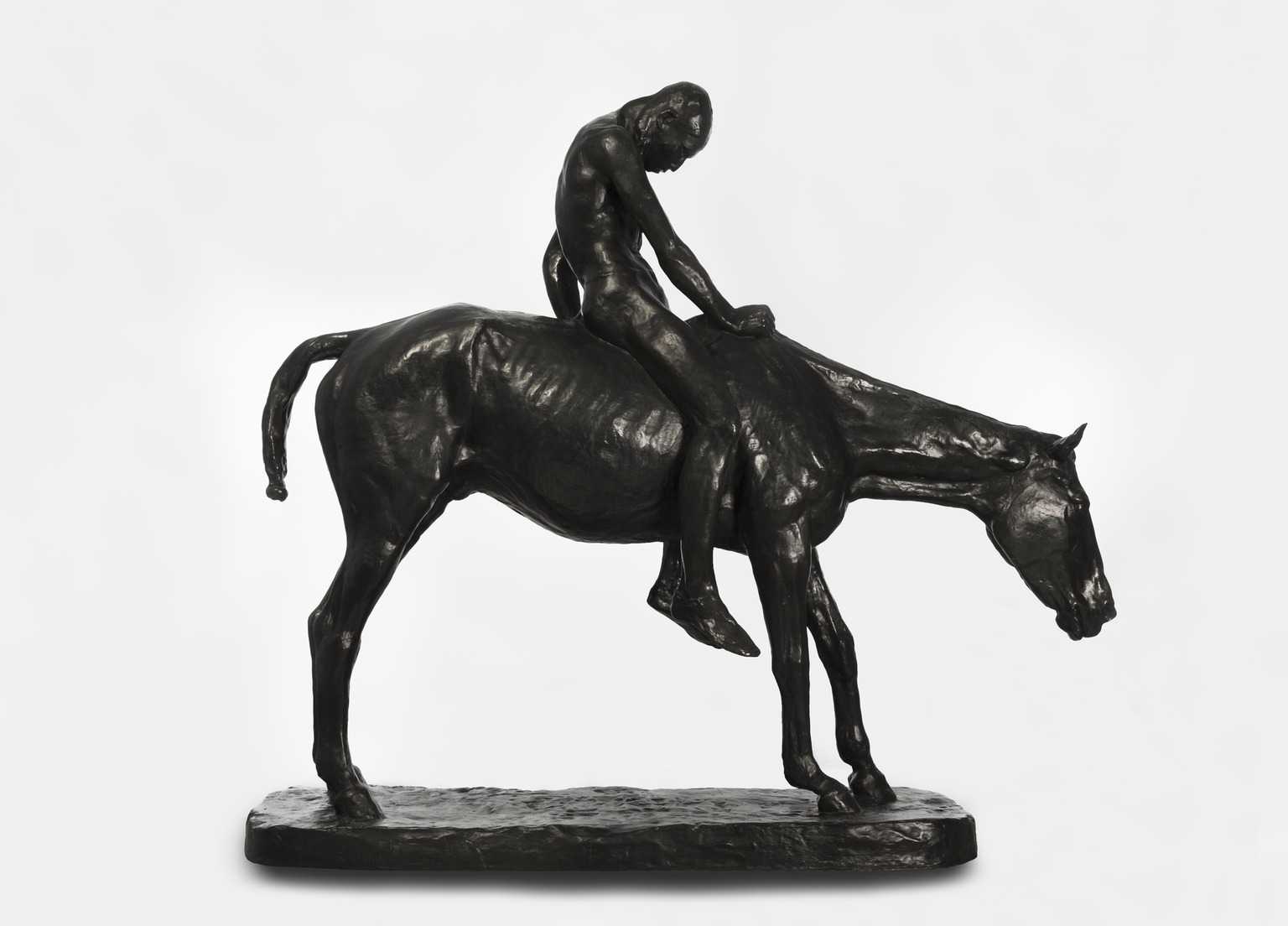
Charles Cary Rumsey (American, 1879–1922). The Dying Indian, 1900s. Brooklyn Museum, Gift of Mrs. Charles Cary Rumsey, 30.917.
LAMY: Yeah, and all this has been developed because of the army. It’s so expensive to develop and it’s to save us, not to save the world. I think Sotheby’s or Christie’s was showing me some AI artists and it was refusing to call them “AI artists.”
GIBSON: Right. I’ve been asked to do AI projects. I do use a lot of digital technology, mainly printing and imaging. Actually, in the sculptures that I’m going to show at the Met—
LAMY: Yeah, we should talk about your show at the Met.
GIBSON: In September, I’m showing four new sculptures on the front of the building, and they’re traditional bronzes. I sculpted maquettes in the studio and completed them with digital sculpting through CGI with the foundry. There’s remarkable-looking parts of the sculptures that I never touched. They only existed in a digital file.
LAMY: You thought about it, and then they exist.
GIBSON: And I worked with them for three-and-a-half years before we arrived here. The digital sculpting was pretty remarkable. We have lots of beadwork on the facade, and every single bead was recreated digitally, even though we use real beads in the maquettes. They’re handmade beads, so none of them are exactly alike. In the digital recreation, there’s randomization that happens through CGI, so we actually are producing hundreds of different kinds of beads through a program that just randomizes.
LAMY: Voila!
GIBSON: We should talk about the color black, Michèle.
LAMY: Okay, if you want.
GIBSON: I saw your quote, and it was funny because I was talking to my now therapist about watching fashion shows with my children. We were watching Rick Owens, the most recent show.
LAMY: The men’s show?
GIBSON: Yeah. I was describing it to him and he said, “I have to see this.” So he watched it and came back and said, “That was really intense.” I was like, “Yeah, we live in intense times.” He said, “Why are you drawn to the color black?” I said, “The thing that I like about Rick Owens and Michèle Lamy is I believe that they see black as not a flat non-color, but a rich space full of infinite possibility. There’s a warmth to the black.” I had never seen your quote about black being a space before, so when I just read that the other day, I thought that was really fantastic. Black obviously has always been used to represent this time of darkness and of sadness, this time of without.
LAMY: It was of the punks, the witches, the ghosts.
GIBSON: Yeah.
LAMY: That’s why when I saw your show and this huge red construction, I’ve been wearing big red clothes.
GIBSON: Amazing.
LAMY: It’s amazing with the black, and it’s nice you saw the show. I hope you will come to our next one. But first, we are going to go to see you at the Met.
GIBSON: Awesome. Michèle, thank you so much for everything you do. It’s such an honor.

